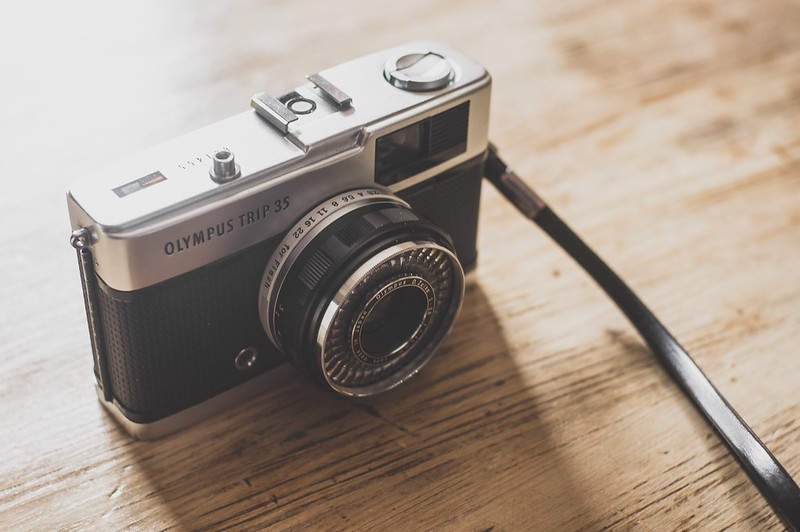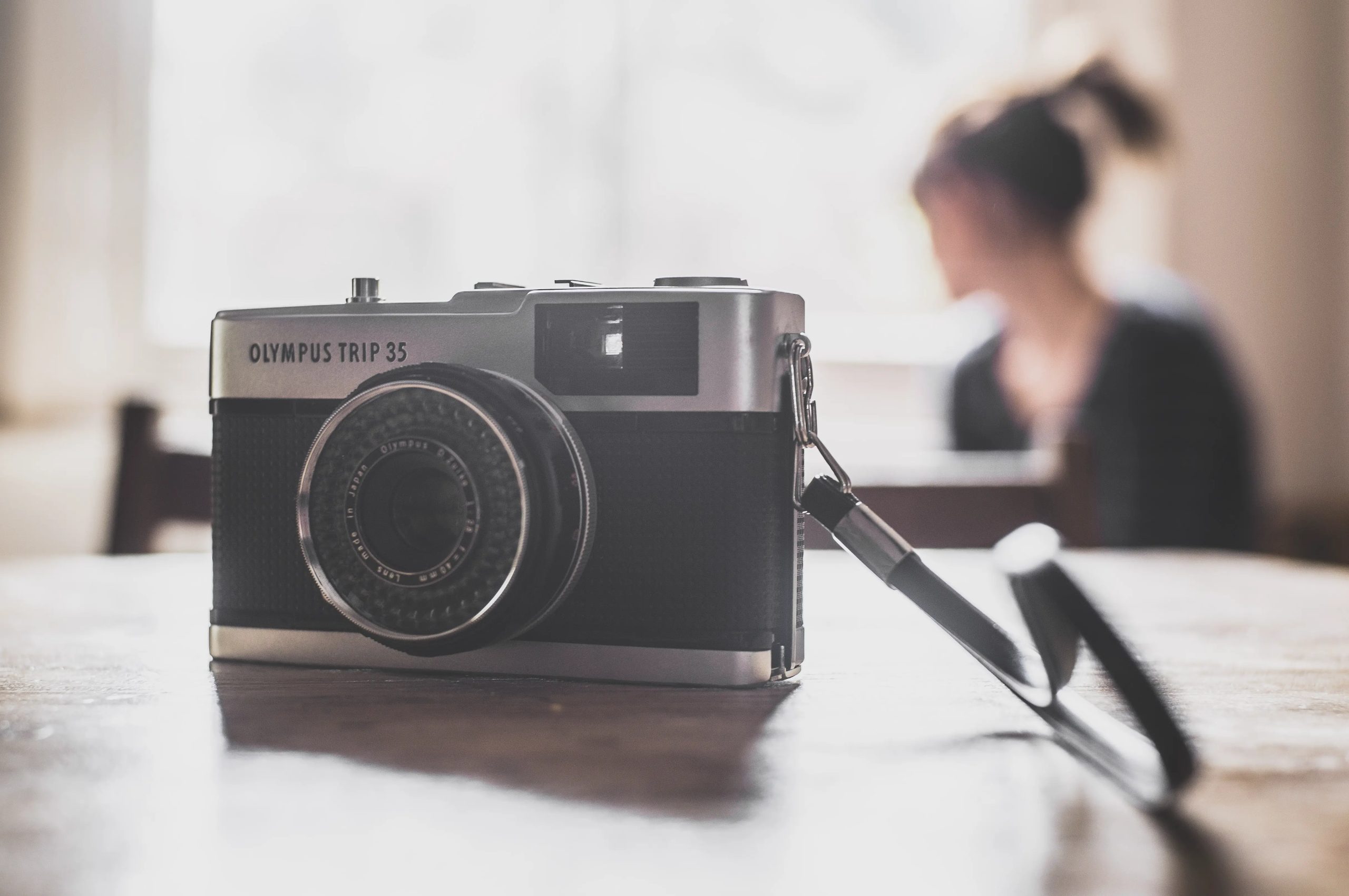I’m certainly not the first and I suspect I won’t be the last to write a little something about the Olympus Trip 35.
I have read this camera had sales figures of around 10,000,000. Olympus used the ‘trip’ moniker on a lot of cameras subsequent to the one in question here, so who knows how many trip 35’s were sold? What is clear is that the number is vast! You only need to go on eBay and see how many are for sale at any one time. Just search for ‘Olympus trip’ on google and you will find entire websites dedicated to the things.
This camera is a popular little snapper and has been since it hit the market in the late 60’s.

It’s production ran from 1967 through to 1984! It’s popularity was helped along by David Bailey and by the fact that the very simple 40mm lens is exceptionally high quality. It was touted as a camera that could take professional quality images yet is small and very easy to use … No wonder they sold so many!
The name “Trip” comes from the the idea that it was intended as a camera for taking on holiday. I guess this translates to a camera for everyone. And that it really is! This camera is a true point and shoot that even the most inexperienced photographer could use with little chance of failure. This is due to the slightly limited but very simple design and operation.
The camera is almost entirely automated for all situations apart from shooting with a flash. Load the camera with a film between 25 and 400iso, set it as such on the dial around the front of the lens and you can let the camera do pretty much the rest.
The selenium cell based light meter effectively powers the cameras operation. With the camera set to ‘A’, based on the light hitting the meter it will choose the most appropriate aperture between f2.8 and f22. It will also choose either 1/40th or 1/200th for the shutter speed. If the amount of light isn’t adequate for at very least 1/40th and f2.8 it will simply prevent the photo from being taken. It tells you this is happening by popping up a little red flag in the viewfinder. If this happens it is intended that the user attach a flash.
If taken off ‘A’ and an aperture selected manually the meter and the flag are disabled and the camera set to shoot at 1/40th. The assumption is that a flash would be attached and that an appropriate aperture for the subjects distance would be selected. Of course it also means that as long as you are happy shooting a 1/40th you can just choose your own aperture and shoot without the little flag stopping you. This does lead to the camera being used more creatively and outside of the way it was intended but more on that later!
Focusing is achieved by selection of one of four possible preset distances which are denoted by four familiar pictures. A head and shoulders for the closest focusing and a picture of mountains for infinity. The second furthest focusing distance (denoted by three little people) is highlighted in red. The same red as the ‘A’. This is no accident, in daylight set the camera to ‘A’ the the three little red people and you can shoot away with little worry of out of focus images.
This simplicity does make for a very enjoyable shooting experience, but with a little imagination the camera can be used (as previously mentioned) outside of the intended way.
The first little trick is quite an obvious one really. The camera can be tricked into over or under exposing by changing the film speed. Eg 200 ISO film in camera and up to 1ev of under exposure can be achieved by setting it to 400iso. You could of course also dial in up to 3ev of over exposure. An example of where this might be useful would be shooting a backlit subject eg a person stood in front of a window.
Another trick is for low light shooting. When set to ‘A’ low light shooting is somewhat limited. That pesky red flag rears its little head and a 400iso limit is a little low.
As mentioned before though, the little red flag can be disabled, and if not using the lightmeter there is no need to worry about what ISO the camera is set to. So as long as you are happy at 1/40th you can put whatever ISO film in you like and manually select exposure with the aperture control. There are in fact many people who do this some of whom post in the Flickr group. It’s not something I have tried since resurrecting the camera… But I’m going to … And will post some shots when I get around to it!
So what’s all the fuss about? Surly there are more highly specified cameras that allow shooting in more circumstances without such limitations. Well yes, but it’s the simplicity that is the charm, combined with a superb lens and the fact that they so rarely go wrong it’s hard not to love this camera!
So that’s the Trip 35, a cult classic, incredibly simple to use, hardy, cheap as chips and packed with charm … Basically, buy one! Use it, love it!
Additional – I have done a ‘Through the viewfinder’ article on this camera which can be found here Through the Viewfinder – Olympus Trip 35
Some useful links:
Help with dating your trip
Instructions for repairing your trip 35
A possibly useful modification
Share this post:









Comments
Trip 35 and some very cheap film and Connie. on Olympus Trip 35 Review – A cult classic point & shoot
Comment posted: 23/05/2013
Olympus Trip 35 on Olympus Trip 35 Review – A cult classic point & shoot
Comment posted: 24/05/2013
Dave on Olympus Trip 35 Review – A cult classic point & shoot
Comment posted: 09/04/2015
Seems like 200@400= 1 stop under....
Comment posted: 09/04/2015
Christos Theofilogiannakos on Olympus Trip 35 Review – A cult classic point & shoot
Comment posted: 16/10/2015
Comment posted: 16/10/2015
Neilson on Olympus Trip 35 Review – A cult classic point & shoot
Comment posted: 25/02/2016
https://www.flickr.com/gp/21156896@N07/05mB9r
5 Frames With An Olympus 35 RC - by Julian Higgs - 35mmc on Olympus Trip 35 Review – A cult classic point & shoot
Comment posted: 03/05/2018
Olympus Trip 35 review - Kosmo Foto on Olympus Trip 35 Review – A cult classic point & shoot
Comment posted: 15/04/2019
Camera Review Blog No. 06 – Olympus Trip 35 – Alex Luyckx | Blog on Olympus Trip 35 Review – A cult classic point & shoot
Comment posted: 26/11/2019
Robert Gerrish on Olympus Trip 35 Review – A cult classic point & shoot
Comment posted: 10/04/2020
David Wignall on Olympus Trip 35 Review – A cult classic point & shoot
Comment posted: 11/11/2021
The only downside of this camera is its low-light shooting capability as 1/40th of a second at f2.8 is its minimum exposure setting and its maximum ISO is only 400. Even so, it can handle medium bright indoors lighting with ISO 400 film. The only option under very low light is to use a flash. Highly recommended : )